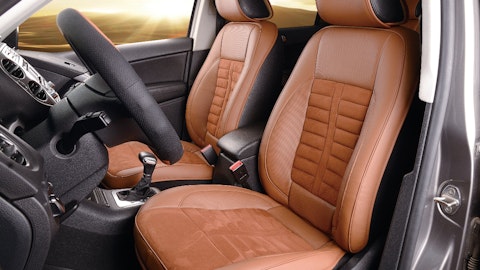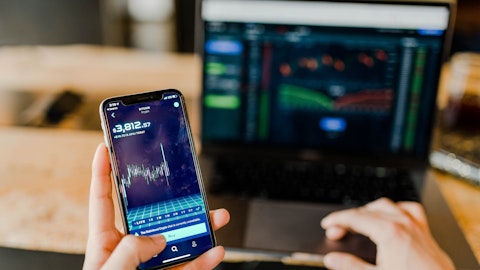Jason Cardew: Yes as you know Rod we’ll formally update our three-year backlog on our fourth quarter earnings call at the beginning of next year. But we continue to win new business at a pace that would support delivering a three-year backlog for 2024 to 2026 that was similar to the most recent backlog. We published $2.85 billion overall $1.8 billion in Seating and $1.05 billion in E-Systems just given the wins that we’ve experienced so far this year. With that being said our plan for 2024 that we released at the beginning of this year was for a $1.5 billion backlog in 2024 would have been the single biggest year in our history. And I think some of the announcements from customers what GM talked about on their earnings call sort of delaying some of the launches maybe reducing near-term volumes.
Ford’s done the same. Others have as well. We would expect that that will have a negative impact on the first year of the backlog in 2024. We still feel confident that the three-year backlog overall will hold up. In our electrification revenue in E-Systems in particular is holding up towards that $1.3 billion target that we had established for 2025. So we’re still seeing really solid growth there with new wins sort of offsetting some of the impact of the volume changes. But — if I look at our 2024 backlog specifically 75% or so of our new business wins in Seating were on electric vehicle platforms. And I would expect based on all of those announcements you could see a 20% or so reduction in that first year with much of that made up in the second and third year of the backlog.
So, yes, you’re right Rod there is an expected impact Dexter, but I think over the three-year period we still feel pretty good about the growth outlook.
Rod Lache: Okay. Great. Thank you.
Jason Cardew: Welcome, Rod.
Operator: Our next question comes from John Murphy from Bank of America. Please go ahead with your question.
John Murphy: Good morning, guys. I just had two quick follow-ups to Rod’s question there and then one other. On the backlog, I mean, if EVs are pushed out presumably there’s other vehicles on ICE that are still made. So on the net backlog you might not — things might not change or actually could potentially be for the better. Is that a fair way to think about that?
Jason Cardew: Yes. I think, absolutely. And I think that coupled with what may happen with the strike the longer it were to continue this year on certain platforms that could benefit next year on ICE vehicles specifically. So I think that kind of real kind of broad base that’s a reasonable assumption that we would also expect stronger ICE volumes apart from the offset.
John Murphy: Yes. And then on E-Systems margins. I mean can you just remind us the target and the time frame as to when you’re what level and where you’re trying to get?
Jason Cardew: Yes. Our target is 8% in 2025. And as we’ve said before it’s not linear between this year and 2025, but we do expect to have a meaningful improvement in operating margins next year. With the run rate of 5.5% in the second half of the year we would expect to continue improving that into next year. Now the backlog will benefit operating margins. There’s a number of puts and takes. Obviously, too early to give guidance. But we — I’d be disappointed if we didn’t have something with a 6% in front of it somewhere in the range next year in E-Systems.
John Murphy: Then just lastly on thermal, you’re making great progress there $1 billion in 2027 10% margins it’s really great to hear. But it seems like it might be a far larger opportunity over time. As you look at the way that thermal is set up in your seats versus the antiquated HVAC system that exists right now and ICE in EVs, is there a potential real content grab and efficiency gain that you could make yourselves and help out the automakers in saving money and then improving efficiency of powertraining the entire vehicle in a big way because you didn’t talk about that. And that seems like a really big deal that this thermal system could shift from antiquated running off the ICE engine to something all new in your seats?
Jason Cardew: Yes. And I think we’ve talked about a partnership and a project we’re working on with Taleo that I think will help us more fully exploit that opportunity. I think you’re right. Longer-term that does create additional growth potential on the Thermal Comfort components specifically. We’ve already embedded a $400 million roughly revenue increase in the Thermal Comfort Systems business over the next four years. So we’ve got a pretty aggressive target. I think longer term where we see even more growth opportunity is in modularity. And so sort of an extension of what we’re doing in Thermal Comfort, but then incorporating our FlexAir products and seat covers on programs where we don’t have the JIT necessarily. I see that as a path to increasing market share in our Seating business overall.
We’ve talked about going from 26% to 29% market share in Seating by 2027. We also see having roughly one-third or 32% of the total seat market when you consider the component sales independent of JIT that we sell to our competitors that are directed by our customers. I don’t see any reason why that number can’t continue to grow three, four, five years down the road as well. And in our target is certainly much more ambitious to maybe capture 35% or 40% of that total seat market over time. I think that’s the real long-term growth driver for the business.
Ray Scott: And just we had a really good review on what we’re doing. And again, I’d say, we’re conservative in how we’re willing to sell, because we’re in the process right now of even validating what Jason just mentioned on a fully modular concept. And the timing obviously, we put the strategy in place eight years ago and we’re building up pieces really give us the complete ability to look at the thing from a manufacturing component perspective and the engineering designs to a modular system that’s integrated right into traditional form or FlexAir into the actual trim cover itself. So all those components layered together really gets to the savings. And I would say, in the other day the timing — there’s a lot of pressure right now on cost and labor scarcity and different challenges within the manufacturing plant couldn’t be better timed.


